University Literature Review: TQM and Continuous Improvement Analysis
VerifiedAdded on 2021/06/14
|16
|3754
|439
Literature Review
AI Summary
This literature review examines Total Quality Management (TQM) and Continuous Improvement, focusing on their impact on business development, specifically within the context of green building projects. The review explores the core concepts of TQM, highlighting its role in enhancing operational efficiency and quality. It delves into Deming's 14 points and Deming Theory, illustrating how these principles facilitate continuous improvement. The analysis covers the characteristics of successful TQM implementation, the application of these practices in real-world scenarios, and provides recommendations for effective implementation. The review emphasizes the importance of employee and customer satisfaction, accident-free operations, fact-based decision-making, and teamwork for successful TQM and continuous improvement initiatives. Ultimately, the review suggests strategies for organizations aiming to leverage TQM and continuous improvement to drive sustainable business growth and enhance project outcomes, particularly in the construction industry.
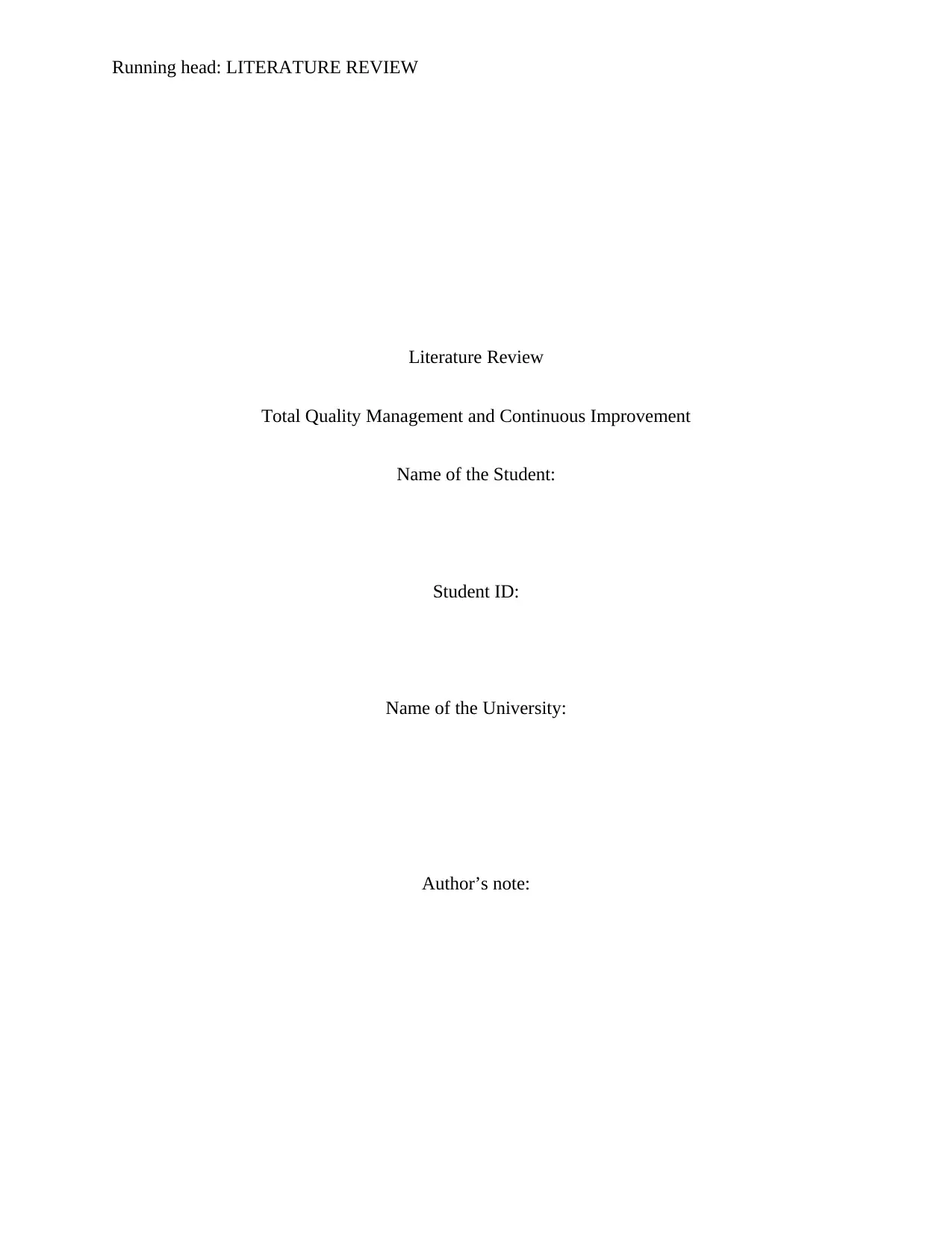
Running head: LITERATURE REVIEW
Literature Review
Total Quality Management and Continuous Improvement
Name of the Student:
Student ID:
Name of the University:
Author’s note:
Literature Review
Total Quality Management and Continuous Improvement
Name of the Student:
Student ID:
Name of the University:
Author’s note:
Paraphrase This Document
Need a fresh take? Get an instant paraphrase of this document with our AI Paraphraser
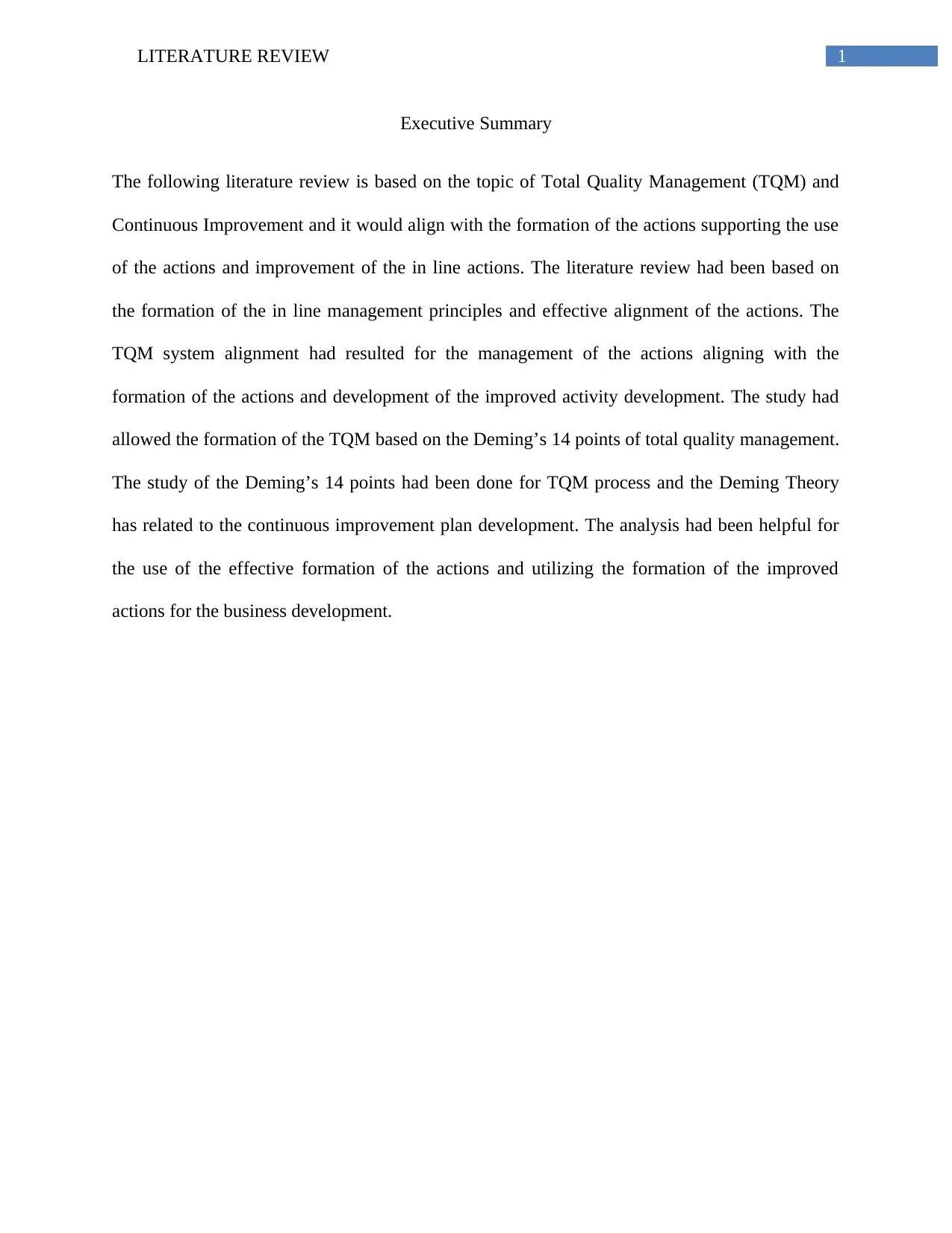
1LITERATURE REVIEW
Executive Summary
The following literature review is based on the topic of Total Quality Management (TQM) and
Continuous Improvement and it would align with the formation of the actions supporting the use
of the actions and improvement of the in line actions. The literature review had been based on
the formation of the in line management principles and effective alignment of the actions. The
TQM system alignment had resulted for the management of the actions aligning with the
formation of the actions and development of the improved activity development. The study had
allowed the formation of the TQM based on the Deming’s 14 points of total quality management.
The study of the Deming’s 14 points had been done for TQM process and the Deming Theory
has related to the continuous improvement plan development. The analysis had been helpful for
the use of the effective formation of the actions and utilizing the formation of the improved
actions for the business development.
Executive Summary
The following literature review is based on the topic of Total Quality Management (TQM) and
Continuous Improvement and it would align with the formation of the actions supporting the use
of the actions and improvement of the in line actions. The literature review had been based on
the formation of the in line management principles and effective alignment of the actions. The
TQM system alignment had resulted for the management of the actions aligning with the
formation of the actions and development of the improved activity development. The study had
allowed the formation of the TQM based on the Deming’s 14 points of total quality management.
The study of the Deming’s 14 points had been done for TQM process and the Deming Theory
has related to the continuous improvement plan development. The analysis had been helpful for
the use of the effective formation of the actions and utilizing the formation of the improved
actions for the business development.
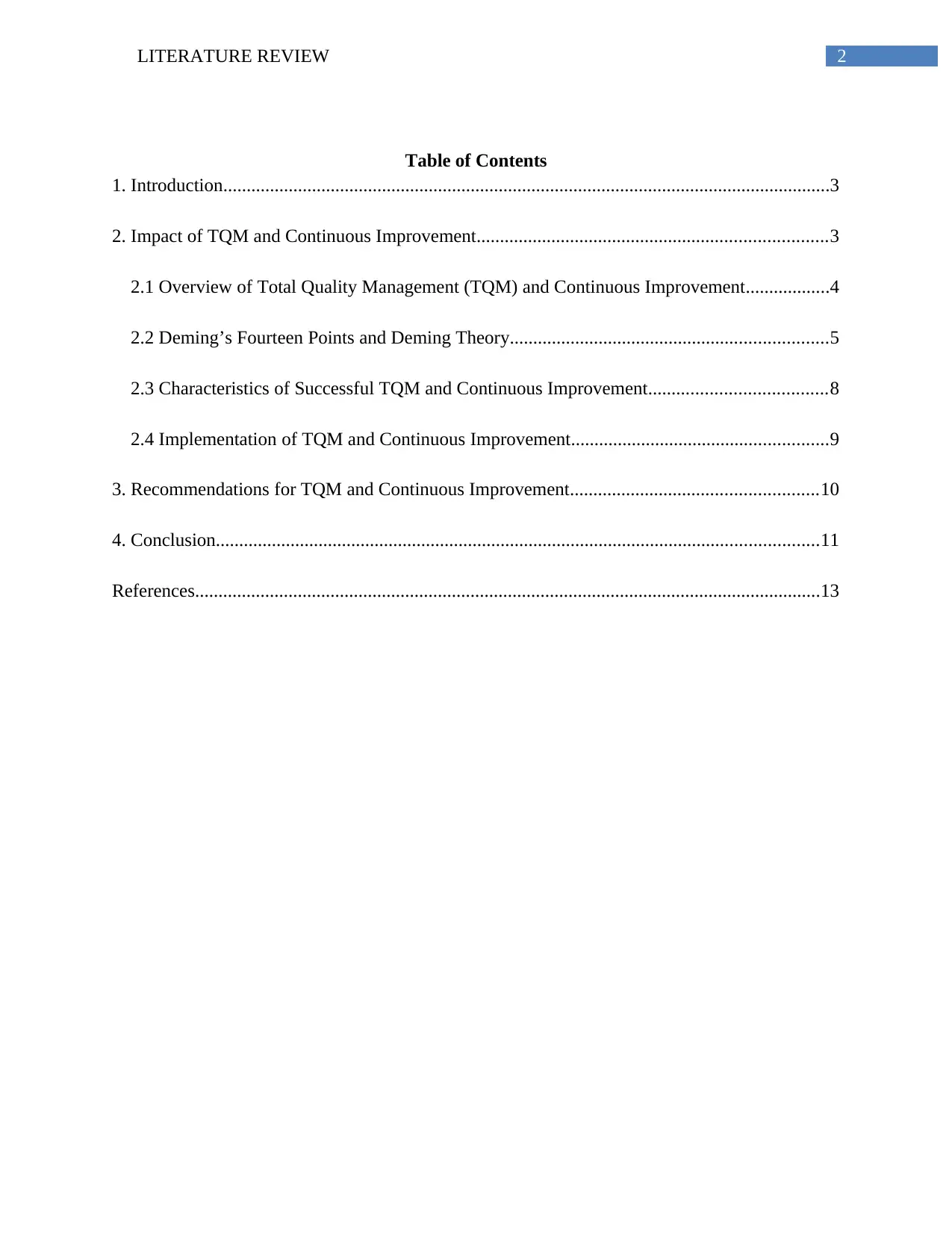
2LITERATURE REVIEW
Table of Contents
1. Introduction..................................................................................................................................3
2. Impact of TQM and Continuous Improvement...........................................................................3
2.1 Overview of Total Quality Management (TQM) and Continuous Improvement..................4
2.2 Deming’s Fourteen Points and Deming Theory....................................................................5
2.3 Characteristics of Successful TQM and Continuous Improvement......................................8
2.4 Implementation of TQM and Continuous Improvement.......................................................9
3. Recommendations for TQM and Continuous Improvement.....................................................10
4. Conclusion.................................................................................................................................11
References......................................................................................................................................13
Table of Contents
1. Introduction..................................................................................................................................3
2. Impact of TQM and Continuous Improvement...........................................................................3
2.1 Overview of Total Quality Management (TQM) and Continuous Improvement..................4
2.2 Deming’s Fourteen Points and Deming Theory....................................................................5
2.3 Characteristics of Successful TQM and Continuous Improvement......................................8
2.4 Implementation of TQM and Continuous Improvement.......................................................9
3. Recommendations for TQM and Continuous Improvement.....................................................10
4. Conclusion.................................................................................................................................11
References......................................................................................................................................13
⊘ This is a preview!⊘
Do you want full access?
Subscribe today to unlock all pages.

Trusted by 1+ million students worldwide
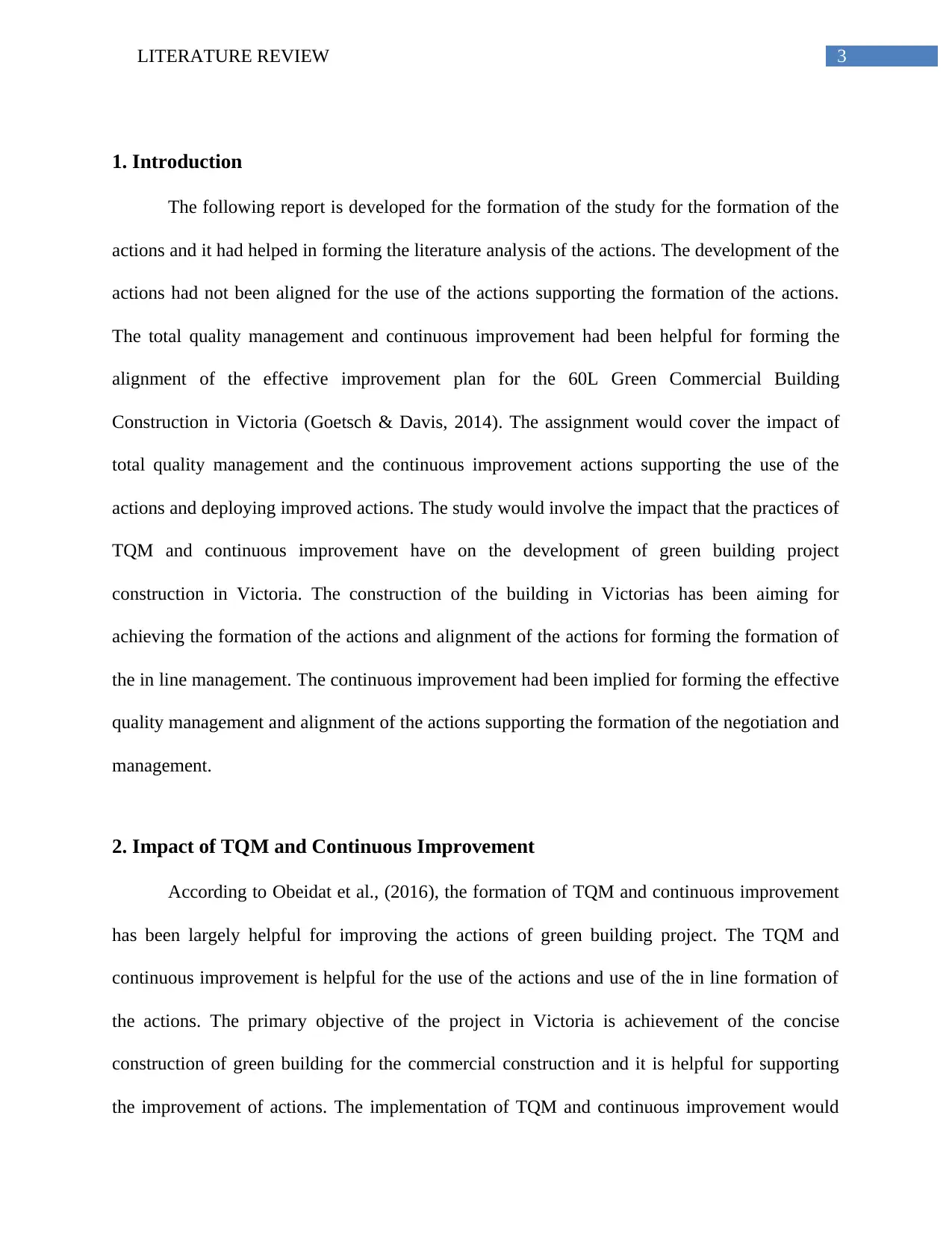
3LITERATURE REVIEW
1. Introduction
The following report is developed for the formation of the study for the formation of the
actions and it had helped in forming the literature analysis of the actions. The development of the
actions had not been aligned for the use of the actions supporting the formation of the actions.
The total quality management and continuous improvement had been helpful for forming the
alignment of the effective improvement plan for the 60L Green Commercial Building
Construction in Victoria (Goetsch & Davis, 2014). The assignment would cover the impact of
total quality management and the continuous improvement actions supporting the use of the
actions and deploying improved actions. The study would involve the impact that the practices of
TQM and continuous improvement have on the development of green building project
construction in Victoria. The construction of the building in Victorias has been aiming for
achieving the formation of the actions and alignment of the actions for forming the formation of
the in line management. The continuous improvement had been implied for forming the effective
quality management and alignment of the actions supporting the formation of the negotiation and
management.
2. Impact of TQM and Continuous Improvement
According to Obeidat et al., (2016), the formation of TQM and continuous improvement
has been largely helpful for improving the actions of green building project. The TQM and
continuous improvement is helpful for the use of the actions and use of the in line formation of
the actions. The primary objective of the project in Victoria is achievement of the concise
construction of green building for the commercial construction and it is helpful for supporting
the improvement of actions. The implementation of TQM and continuous improvement would
1. Introduction
The following report is developed for the formation of the study for the formation of the
actions and it had helped in forming the literature analysis of the actions. The development of the
actions had not been aligned for the use of the actions supporting the formation of the actions.
The total quality management and continuous improvement had been helpful for forming the
alignment of the effective improvement plan for the 60L Green Commercial Building
Construction in Victoria (Goetsch & Davis, 2014). The assignment would cover the impact of
total quality management and the continuous improvement actions supporting the use of the
actions and deploying improved actions. The study would involve the impact that the practices of
TQM and continuous improvement have on the development of green building project
construction in Victoria. The construction of the building in Victorias has been aiming for
achieving the formation of the actions and alignment of the actions for forming the formation of
the in line management. The continuous improvement had been implied for forming the effective
quality management and alignment of the actions supporting the formation of the negotiation and
management.
2. Impact of TQM and Continuous Improvement
According to Obeidat et al., (2016), the formation of TQM and continuous improvement
has been largely helpful for improving the actions of green building project. The TQM and
continuous improvement is helpful for the use of the actions and use of the in line formation of
the actions. The primary objective of the project in Victoria is achievement of the concise
construction of green building for the commercial construction and it is helpful for supporting
the improvement of actions. The implementation of TQM and continuous improvement would
Paraphrase This Document
Need a fresh take? Get an instant paraphrase of this document with our AI Paraphraser
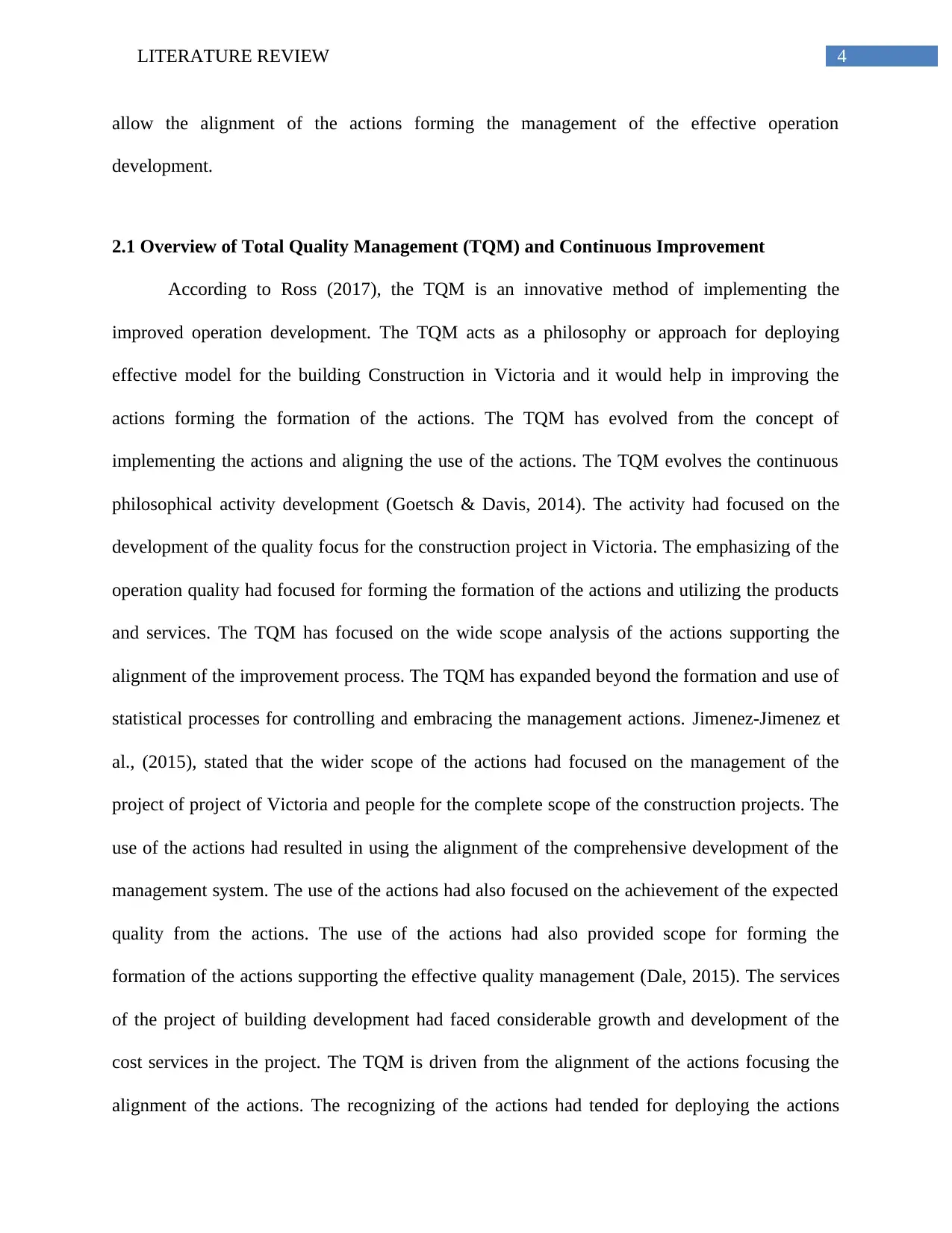
4LITERATURE REVIEW
allow the alignment of the actions forming the management of the effective operation
development.
2.1 Overview of Total Quality Management (TQM) and Continuous Improvement
According to Ross (2017), the TQM is an innovative method of implementing the
improved operation development. The TQM acts as a philosophy or approach for deploying
effective model for the building Construction in Victoria and it would help in improving the
actions forming the formation of the actions. The TQM has evolved from the concept of
implementing the actions and aligning the use of the actions. The TQM evolves the continuous
philosophical activity development (Goetsch & Davis, 2014). The activity had focused on the
development of the quality focus for the construction project in Victoria. The emphasizing of the
operation quality had focused for forming the formation of the actions and utilizing the products
and services. The TQM has focused on the wide scope analysis of the actions supporting the
alignment of the improvement process. The TQM has expanded beyond the formation and use of
statistical processes for controlling and embracing the management actions. Jimenez-Jimenez et
al., (2015), stated that the wider scope of the actions had focused on the management of the
project of project of Victoria and people for the complete scope of the construction projects. The
use of the actions had resulted in using the alignment of the comprehensive development of the
management system. The use of the actions had also focused on the achievement of the expected
quality from the actions. The use of the actions had also provided scope for forming the
formation of the actions supporting the effective quality management (Dale, 2015). The services
of the project of building development had faced considerable growth and development of the
cost services in the project. The TQM is driven from the alignment of the actions focusing the
alignment of the actions. The recognizing of the actions had tended for deploying the actions
allow the alignment of the actions forming the management of the effective operation
development.
2.1 Overview of Total Quality Management (TQM) and Continuous Improvement
According to Ross (2017), the TQM is an innovative method of implementing the
improved operation development. The TQM acts as a philosophy or approach for deploying
effective model for the building Construction in Victoria and it would help in improving the
actions forming the formation of the actions. The TQM has evolved from the concept of
implementing the actions and aligning the use of the actions. The TQM evolves the continuous
philosophical activity development (Goetsch & Davis, 2014). The activity had focused on the
development of the quality focus for the construction project in Victoria. The emphasizing of the
operation quality had focused for forming the formation of the actions and utilizing the products
and services. The TQM has focused on the wide scope analysis of the actions supporting the
alignment of the improvement process. The TQM has expanded beyond the formation and use of
statistical processes for controlling and embracing the management actions. Jimenez-Jimenez et
al., (2015), stated that the wider scope of the actions had focused on the management of the
project of project of Victoria and people for the complete scope of the construction projects. The
use of the actions had resulted in using the alignment of the comprehensive development of the
management system. The use of the actions had also focused on the achievement of the expected
quality from the actions. The use of the actions had also provided scope for forming the
formation of the actions supporting the effective quality management (Dale, 2015). The services
of the project of building development had faced considerable growth and development of the
cost services in the project. The TQM is driven from the alignment of the actions focusing the
alignment of the actions. The recognizing of the actions had tended for deploying the actions
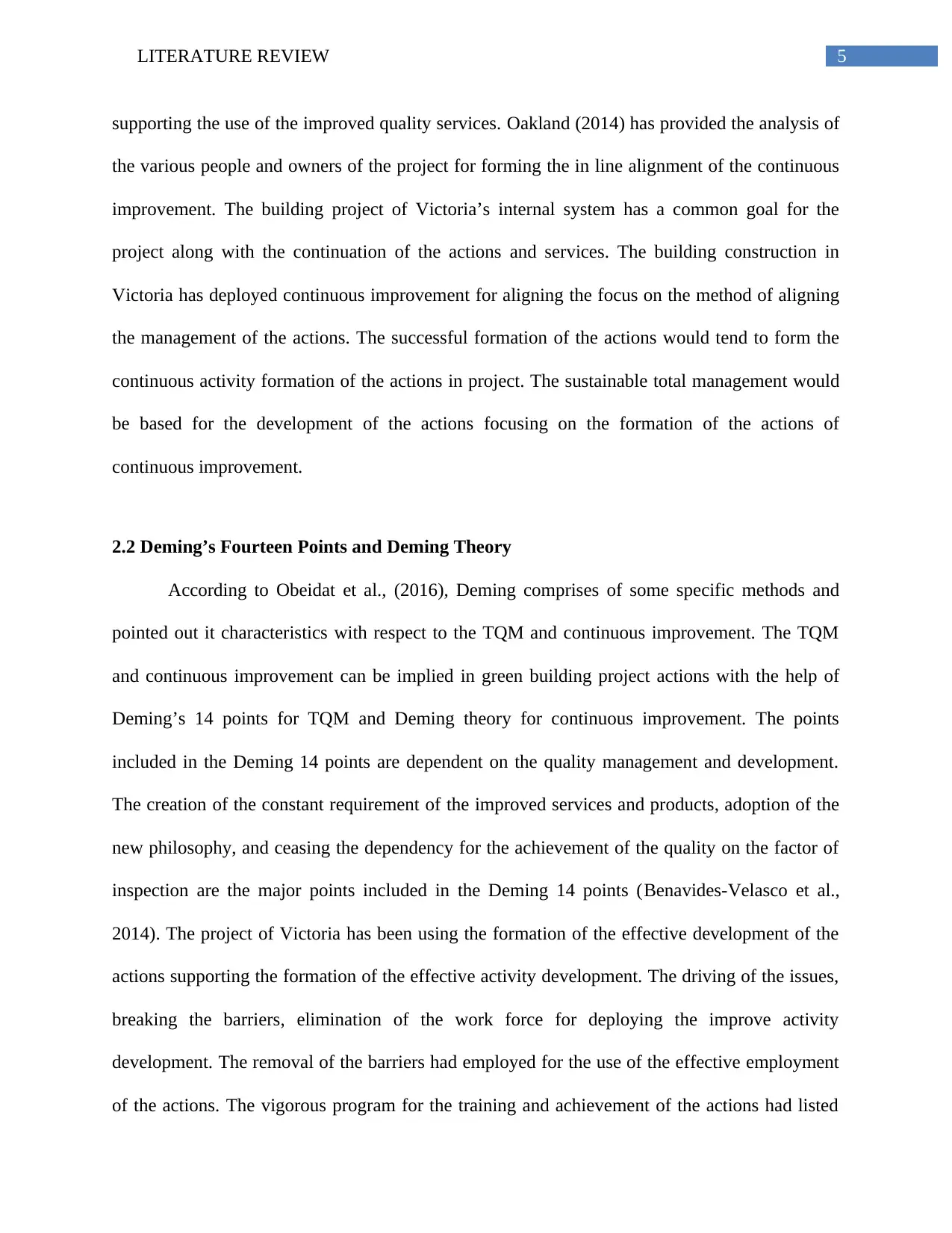
5LITERATURE REVIEW
supporting the use of the improved quality services. Oakland (2014) has provided the analysis of
the various people and owners of the project for forming the in line alignment of the continuous
improvement. The building project of Victoria’s internal system has a common goal for the
project along with the continuation of the actions and services. The building construction in
Victoria has deployed continuous improvement for aligning the focus on the method of aligning
the management of the actions. The successful formation of the actions would tend to form the
continuous activity formation of the actions in project. The sustainable total management would
be based for the development of the actions focusing on the formation of the actions of
continuous improvement.
2.2 Deming’s Fourteen Points and Deming Theory
According to Obeidat et al., (2016), Deming comprises of some specific methods and
pointed out it characteristics with respect to the TQM and continuous improvement. The TQM
and continuous improvement can be implied in green building project actions with the help of
Deming’s 14 points for TQM and Deming theory for continuous improvement. The points
included in the Deming 14 points are dependent on the quality management and development.
The creation of the constant requirement of the improved services and products, adoption of the
new philosophy, and ceasing the dependency for the achievement of the quality on the factor of
inspection are the major points included in the Deming 14 points (Benavides-Velasco et al.,
2014). The project of Victoria has been using the formation of the effective development of the
actions supporting the formation of the effective activity development. The driving of the issues,
breaking the barriers, elimination of the work force for deploying the improve activity
development. The removal of the barriers had employed for the use of the effective employment
of the actions. The vigorous program for the training and achievement of the actions had listed
supporting the use of the improved quality services. Oakland (2014) has provided the analysis of
the various people and owners of the project for forming the in line alignment of the continuous
improvement. The building project of Victoria’s internal system has a common goal for the
project along with the continuation of the actions and services. The building construction in
Victoria has deployed continuous improvement for aligning the focus on the method of aligning
the management of the actions. The successful formation of the actions would tend to form the
continuous activity formation of the actions in project. The sustainable total management would
be based for the development of the actions focusing on the formation of the actions of
continuous improvement.
2.2 Deming’s Fourteen Points and Deming Theory
According to Obeidat et al., (2016), Deming comprises of some specific methods and
pointed out it characteristics with respect to the TQM and continuous improvement. The TQM
and continuous improvement can be implied in green building project actions with the help of
Deming’s 14 points for TQM and Deming theory for continuous improvement. The points
included in the Deming 14 points are dependent on the quality management and development.
The creation of the constant requirement of the improved services and products, adoption of the
new philosophy, and ceasing the dependency for the achievement of the quality on the factor of
inspection are the major points included in the Deming 14 points (Benavides-Velasco et al.,
2014). The project of Victoria has been using the formation of the effective development of the
actions supporting the formation of the effective activity development. The driving of the issues,
breaking the barriers, elimination of the work force for deploying the improve activity
development. The removal of the barriers had employed for the use of the effective employment
of the actions. The vigorous program for the training and achievement of the actions had listed
⊘ This is a preview!⊘
Do you want full access?
Subscribe today to unlock all pages.

Trusted by 1+ million students worldwide
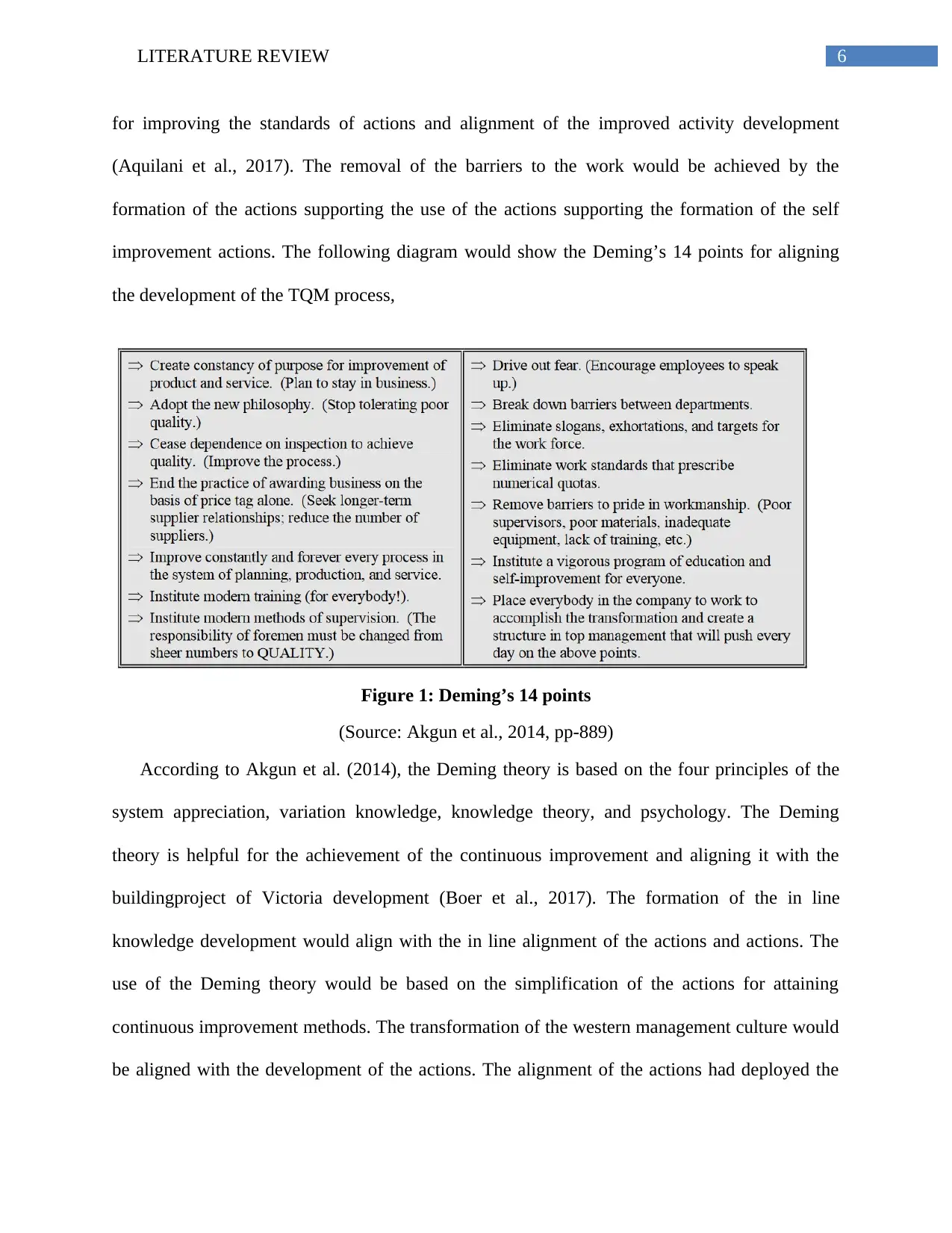
6LITERATURE REVIEW
for improving the standards of actions and alignment of the improved activity development
(Aquilani et al., 2017). The removal of the barriers to the work would be achieved by the
formation of the actions supporting the use of the actions supporting the formation of the self
improvement actions. The following diagram would show the Deming’s 14 points for aligning
the development of the TQM process,
Figure 1: Deming’s 14 points
(Source: Akgun et al., 2014, pp-889)
According to Akgun et al. (2014), the Deming theory is based on the four principles of the
system appreciation, variation knowledge, knowledge theory, and psychology. The Deming
theory is helpful for the achievement of the continuous improvement and aligning it with the
buildingproject of Victoria development (Boer et al., 2017). The formation of the in line
knowledge development would align with the in line alignment of the actions and actions. The
use of the Deming theory would be based on the simplification of the actions for attaining
continuous improvement methods. The transformation of the western management culture would
be aligned with the development of the actions. The alignment of the actions had deployed the
for improving the standards of actions and alignment of the improved activity development
(Aquilani et al., 2017). The removal of the barriers to the work would be achieved by the
formation of the actions supporting the use of the actions supporting the formation of the self
improvement actions. The following diagram would show the Deming’s 14 points for aligning
the development of the TQM process,
Figure 1: Deming’s 14 points
(Source: Akgun et al., 2014, pp-889)
According to Akgun et al. (2014), the Deming theory is based on the four principles of the
system appreciation, variation knowledge, knowledge theory, and psychology. The Deming
theory is helpful for the achievement of the continuous improvement and aligning it with the
buildingproject of Victoria development (Boer et al., 2017). The formation of the in line
knowledge development would align with the in line alignment of the actions and actions. The
use of the Deming theory would be based on the simplification of the actions for attaining
continuous improvement methods. The transformation of the western management culture would
be aligned with the development of the actions. The alignment of the actions had deployed the
Paraphrase This Document
Need a fresh take? Get an instant paraphrase of this document with our AI Paraphraser
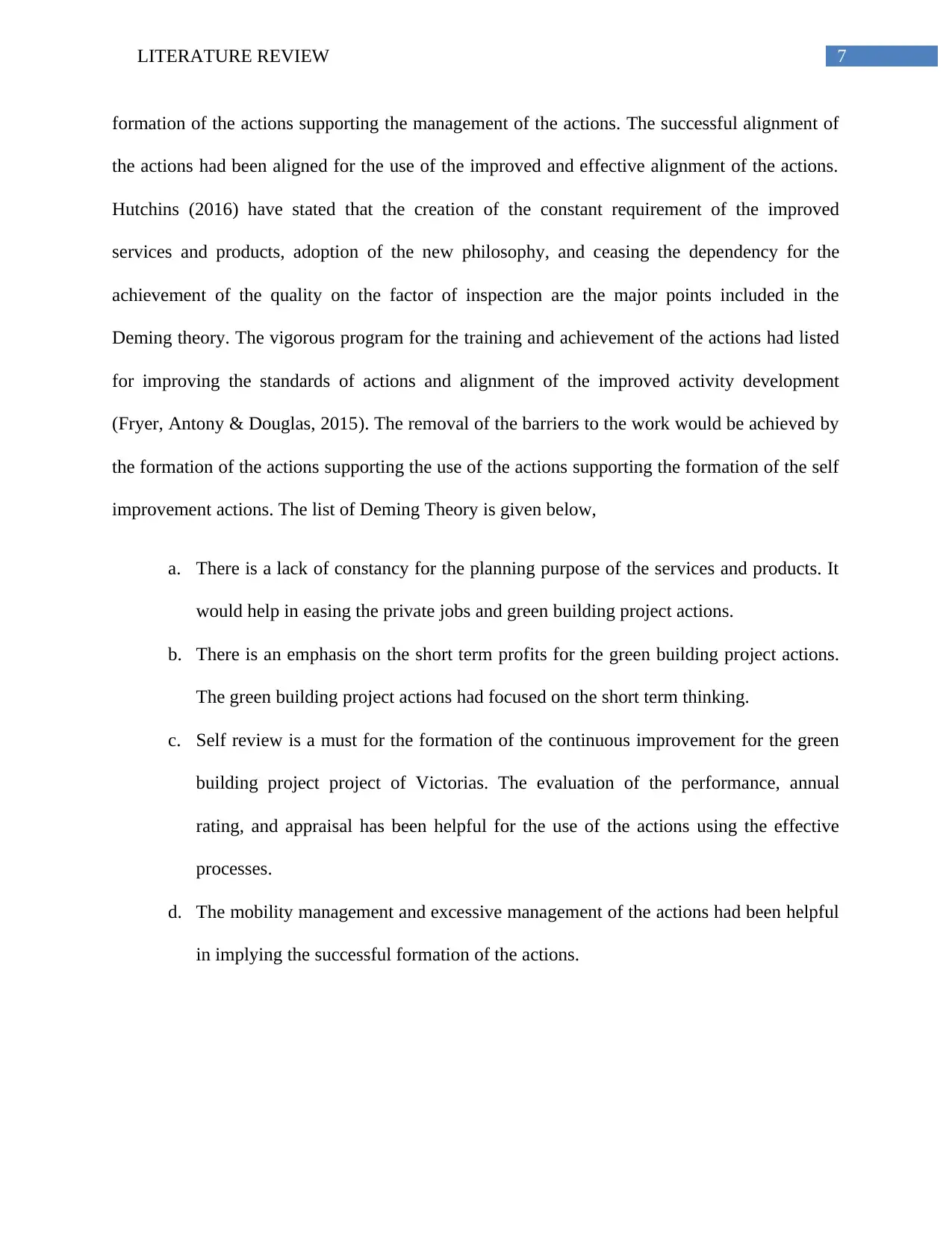
7LITERATURE REVIEW
formation of the actions supporting the management of the actions. The successful alignment of
the actions had been aligned for the use of the improved and effective alignment of the actions.
Hutchins (2016) have stated that the creation of the constant requirement of the improved
services and products, adoption of the new philosophy, and ceasing the dependency for the
achievement of the quality on the factor of inspection are the major points included in the
Deming theory. The vigorous program for the training and achievement of the actions had listed
for improving the standards of actions and alignment of the improved activity development
(Fryer, Antony & Douglas, 2015). The removal of the barriers to the work would be achieved by
the formation of the actions supporting the use of the actions supporting the formation of the self
improvement actions. The list of Deming Theory is given below,
a. There is a lack of constancy for the planning purpose of the services and products. It
would help in easing the private jobs and green building project actions.
b. There is an emphasis on the short term profits for the green building project actions.
The green building project actions had focused on the short term thinking.
c. Self review is a must for the formation of the continuous improvement for the green
building project project of Victorias. The evaluation of the performance, annual
rating, and appraisal has been helpful for the use of the actions using the effective
processes.
d. The mobility management and excessive management of the actions had been helpful
in implying the successful formation of the actions.
formation of the actions supporting the management of the actions. The successful alignment of
the actions had been aligned for the use of the improved and effective alignment of the actions.
Hutchins (2016) have stated that the creation of the constant requirement of the improved
services and products, adoption of the new philosophy, and ceasing the dependency for the
achievement of the quality on the factor of inspection are the major points included in the
Deming theory. The vigorous program for the training and achievement of the actions had listed
for improving the standards of actions and alignment of the improved activity development
(Fryer, Antony & Douglas, 2015). The removal of the barriers to the work would be achieved by
the formation of the actions supporting the use of the actions supporting the formation of the self
improvement actions. The list of Deming Theory is given below,
a. There is a lack of constancy for the planning purpose of the services and products. It
would help in easing the private jobs and green building project actions.
b. There is an emphasis on the short term profits for the green building project actions.
The green building project actions had focused on the short term thinking.
c. Self review is a must for the formation of the continuous improvement for the green
building project project of Victorias. The evaluation of the performance, annual
rating, and appraisal has been helpful for the use of the actions using the effective
processes.
d. The mobility management and excessive management of the actions had been helpful
in implying the successful formation of the actions.
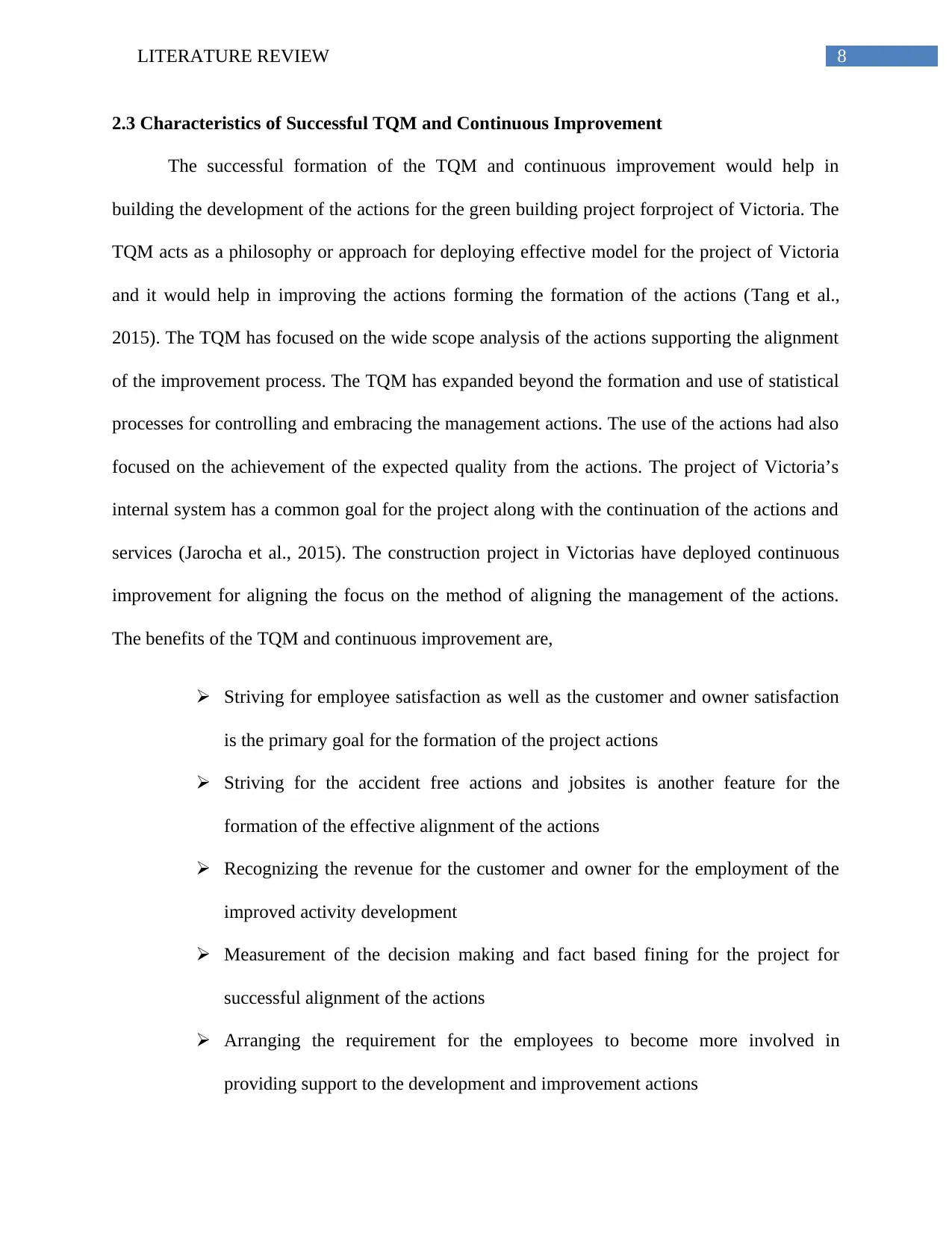
8LITERATURE REVIEW
2.3 Characteristics of Successful TQM and Continuous Improvement
The successful formation of the TQM and continuous improvement would help in
building the development of the actions for the green building project forproject of Victoria. The
TQM acts as a philosophy or approach for deploying effective model for the project of Victoria
and it would help in improving the actions forming the formation of the actions (Tang et al.,
2015). The TQM has focused on the wide scope analysis of the actions supporting the alignment
of the improvement process. The TQM has expanded beyond the formation and use of statistical
processes for controlling and embracing the management actions. The use of the actions had also
focused on the achievement of the expected quality from the actions. The project of Victoria’s
internal system has a common goal for the project along with the continuation of the actions and
services (Jarocha et al., 2015). The construction project in Victorias have deployed continuous
improvement for aligning the focus on the method of aligning the management of the actions.
The benefits of the TQM and continuous improvement are,
Striving for employee satisfaction as well as the customer and owner satisfaction
is the primary goal for the formation of the project actions
Striving for the accident free actions and jobsites is another feature for the
formation of the effective alignment of the actions
Recognizing the revenue for the customer and owner for the employment of the
improved activity development
Measurement of the decision making and fact based fining for the project for
successful alignment of the actions
Arranging the requirement for the employees to become more involved in
providing support to the development and improvement actions
2.3 Characteristics of Successful TQM and Continuous Improvement
The successful formation of the TQM and continuous improvement would help in
building the development of the actions for the green building project forproject of Victoria. The
TQM acts as a philosophy or approach for deploying effective model for the project of Victoria
and it would help in improving the actions forming the formation of the actions (Tang et al.,
2015). The TQM has focused on the wide scope analysis of the actions supporting the alignment
of the improvement process. The TQM has expanded beyond the formation and use of statistical
processes for controlling and embracing the management actions. The use of the actions had also
focused on the achievement of the expected quality from the actions. The project of Victoria’s
internal system has a common goal for the project along with the continuation of the actions and
services (Jarocha et al., 2015). The construction project in Victorias have deployed continuous
improvement for aligning the focus on the method of aligning the management of the actions.
The benefits of the TQM and continuous improvement are,
Striving for employee satisfaction as well as the customer and owner satisfaction
is the primary goal for the formation of the project actions
Striving for the accident free actions and jobsites is another feature for the
formation of the effective alignment of the actions
Recognizing the revenue for the customer and owner for the employment of the
improved activity development
Measurement of the decision making and fact based fining for the project for
successful alignment of the actions
Arranging the requirement for the employees to become more involved in
providing support to the development and improvement actions
⊘ This is a preview!⊘
Do you want full access?
Subscribe today to unlock all pages.

Trusted by 1+ million students worldwide
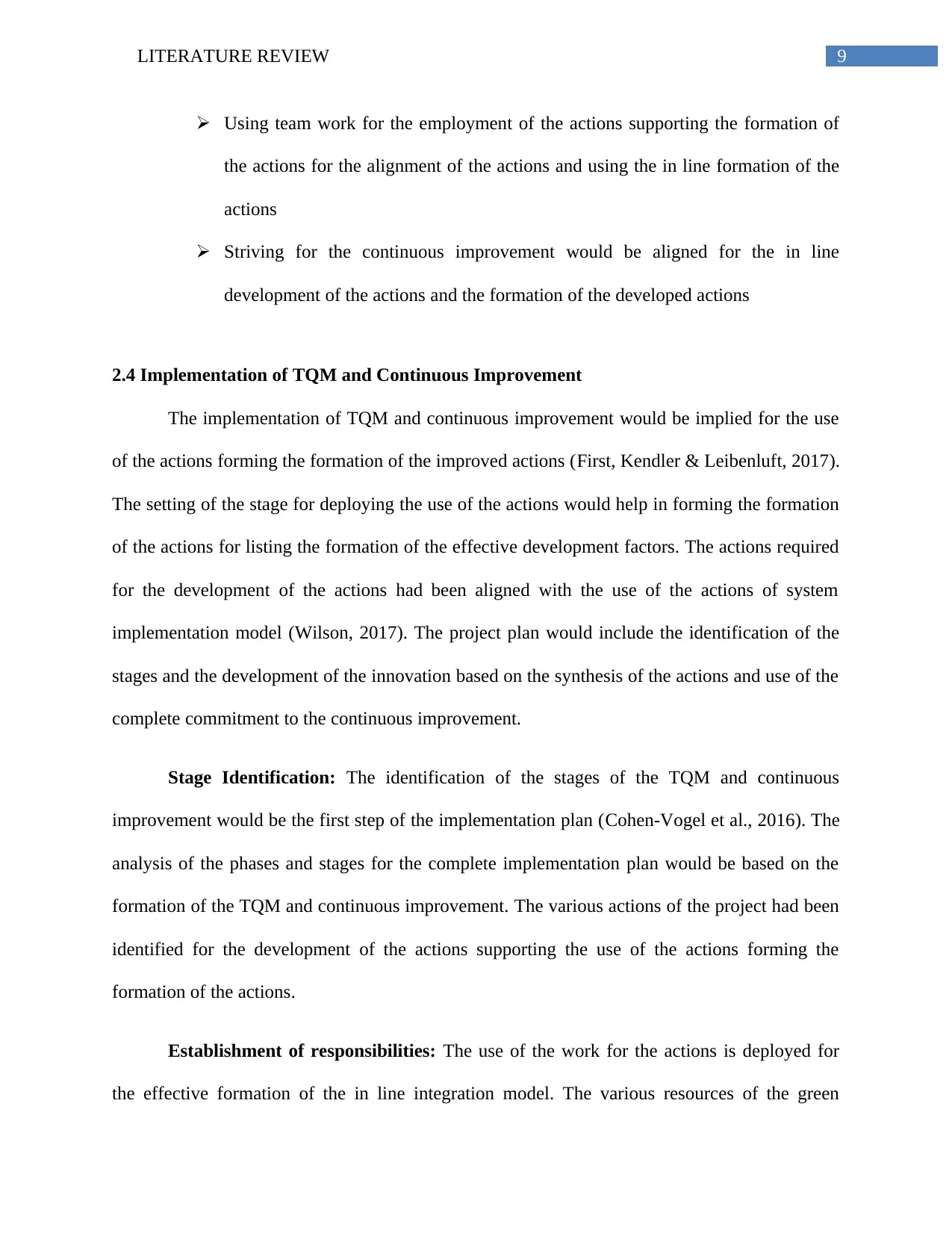
9LITERATURE REVIEW
Using team work for the employment of the actions supporting the formation of
the actions for the alignment of the actions and using the in line formation of the
actions
Striving for the continuous improvement would be aligned for the in line
development of the actions and the formation of the developed actions
2.4 Implementation of TQM and Continuous Improvement
The implementation of TQM and continuous improvement would be implied for the use
of the actions forming the formation of the improved actions (First, Kendler & Leibenluft, 2017).
The setting of the stage for deploying the use of the actions would help in forming the formation
of the actions for listing the formation of the effective development factors. The actions required
for the development of the actions had been aligned with the use of the actions of system
implementation model (Wilson, 2017). The project plan would include the identification of the
stages and the development of the innovation based on the synthesis of the actions and use of the
complete commitment to the continuous improvement.
Stage Identification: The identification of the stages of the TQM and continuous
improvement would be the first step of the implementation plan (Cohen-Vogel et al., 2016). The
analysis of the phases and stages for the complete implementation plan would be based on the
formation of the TQM and continuous improvement. The various actions of the project had been
identified for the development of the actions supporting the use of the actions forming the
formation of the actions.
Establishment of responsibilities: The use of the work for the actions is deployed for
the effective formation of the in line integration model. The various resources of the green
Using team work for the employment of the actions supporting the formation of
the actions for the alignment of the actions and using the in line formation of the
actions
Striving for the continuous improvement would be aligned for the in line
development of the actions and the formation of the developed actions
2.4 Implementation of TQM and Continuous Improvement
The implementation of TQM and continuous improvement would be implied for the use
of the actions forming the formation of the improved actions (First, Kendler & Leibenluft, 2017).
The setting of the stage for deploying the use of the actions would help in forming the formation
of the actions for listing the formation of the effective development factors. The actions required
for the development of the actions had been aligned with the use of the actions of system
implementation model (Wilson, 2017). The project plan would include the identification of the
stages and the development of the innovation based on the synthesis of the actions and use of the
complete commitment to the continuous improvement.
Stage Identification: The identification of the stages of the TQM and continuous
improvement would be the first step of the implementation plan (Cohen-Vogel et al., 2016). The
analysis of the phases and stages for the complete implementation plan would be based on the
formation of the TQM and continuous improvement. The various actions of the project had been
identified for the development of the actions supporting the use of the actions forming the
formation of the actions.
Establishment of responsibilities: The use of the work for the actions is deployed for
the effective formation of the in line integration model. The various resources of the green
Paraphrase This Document
Need a fresh take? Get an instant paraphrase of this document with our AI Paraphraser
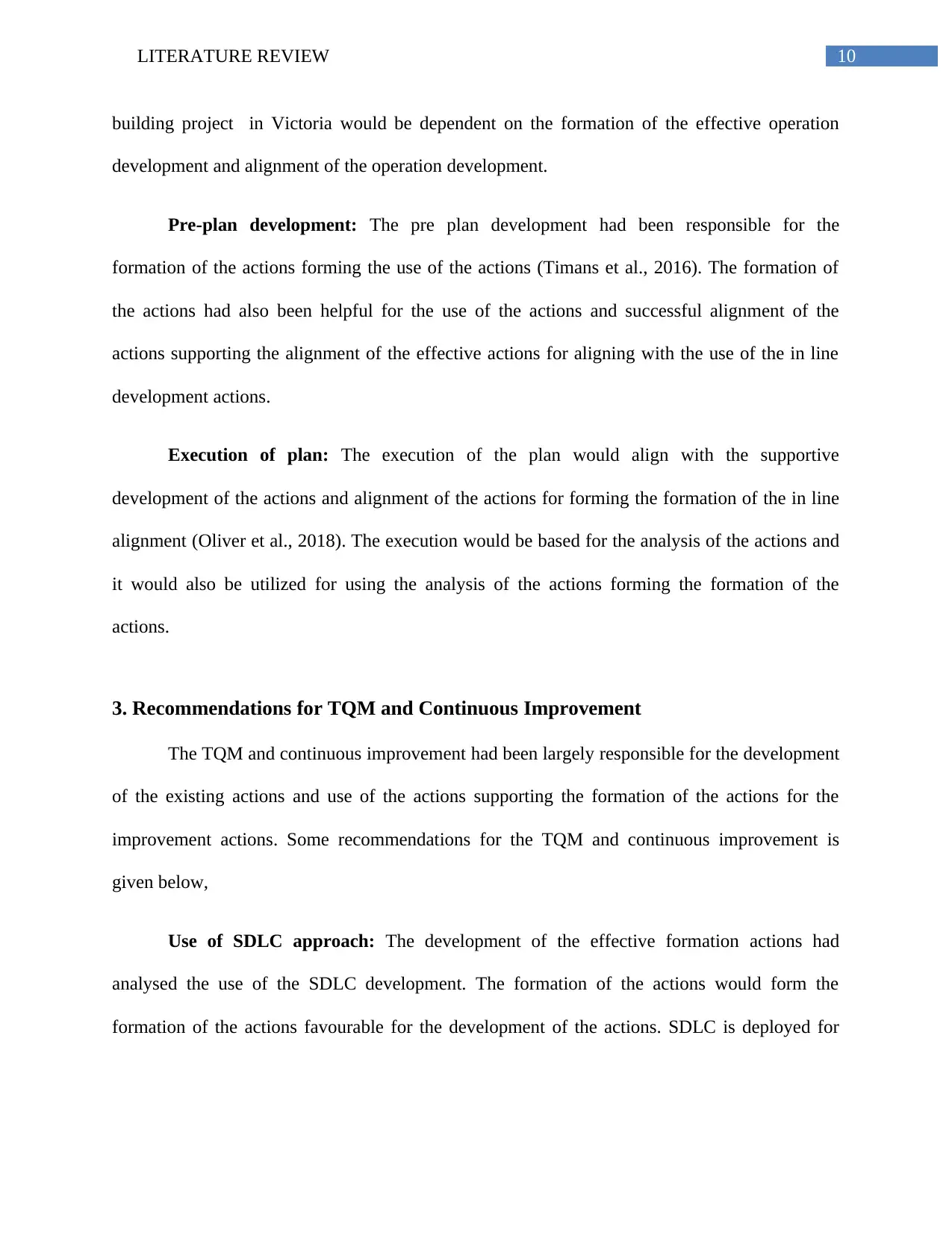
10LITERATURE REVIEW
building project in Victoria would be dependent on the formation of the effective operation
development and alignment of the operation development.
Pre-plan development: The pre plan development had been responsible for the
formation of the actions forming the use of the actions (Timans et al., 2016). The formation of
the actions had also been helpful for the use of the actions and successful alignment of the
actions supporting the alignment of the effective actions for aligning with the use of the in line
development actions.
Execution of plan: The execution of the plan would align with the supportive
development of the actions and alignment of the actions for forming the formation of the in line
alignment (Oliver et al., 2018). The execution would be based for the analysis of the actions and
it would also be utilized for using the analysis of the actions forming the formation of the
actions.
3. Recommendations for TQM and Continuous Improvement
The TQM and continuous improvement had been largely responsible for the development
of the existing actions and use of the actions supporting the formation of the actions for the
improvement actions. Some recommendations for the TQM and continuous improvement is
given below,
Use of SDLC approach: The development of the effective formation actions had
analysed the use of the SDLC development. The formation of the actions would form the
formation of the actions favourable for the development of the actions. SDLC is deployed for
building project in Victoria would be dependent on the formation of the effective operation
development and alignment of the operation development.
Pre-plan development: The pre plan development had been responsible for the
formation of the actions forming the use of the actions (Timans et al., 2016). The formation of
the actions had also been helpful for the use of the actions and successful alignment of the
actions supporting the alignment of the effective actions for aligning with the use of the in line
development actions.
Execution of plan: The execution of the plan would align with the supportive
development of the actions and alignment of the actions for forming the formation of the in line
alignment (Oliver et al., 2018). The execution would be based for the analysis of the actions and
it would also be utilized for using the analysis of the actions forming the formation of the
actions.
3. Recommendations for TQM and Continuous Improvement
The TQM and continuous improvement had been largely responsible for the development
of the existing actions and use of the actions supporting the formation of the actions for the
improvement actions. Some recommendations for the TQM and continuous improvement is
given below,
Use of SDLC approach: The development of the effective formation actions had
analysed the use of the SDLC development. The formation of the actions would form the
formation of the actions favourable for the development of the actions. SDLC is deployed for
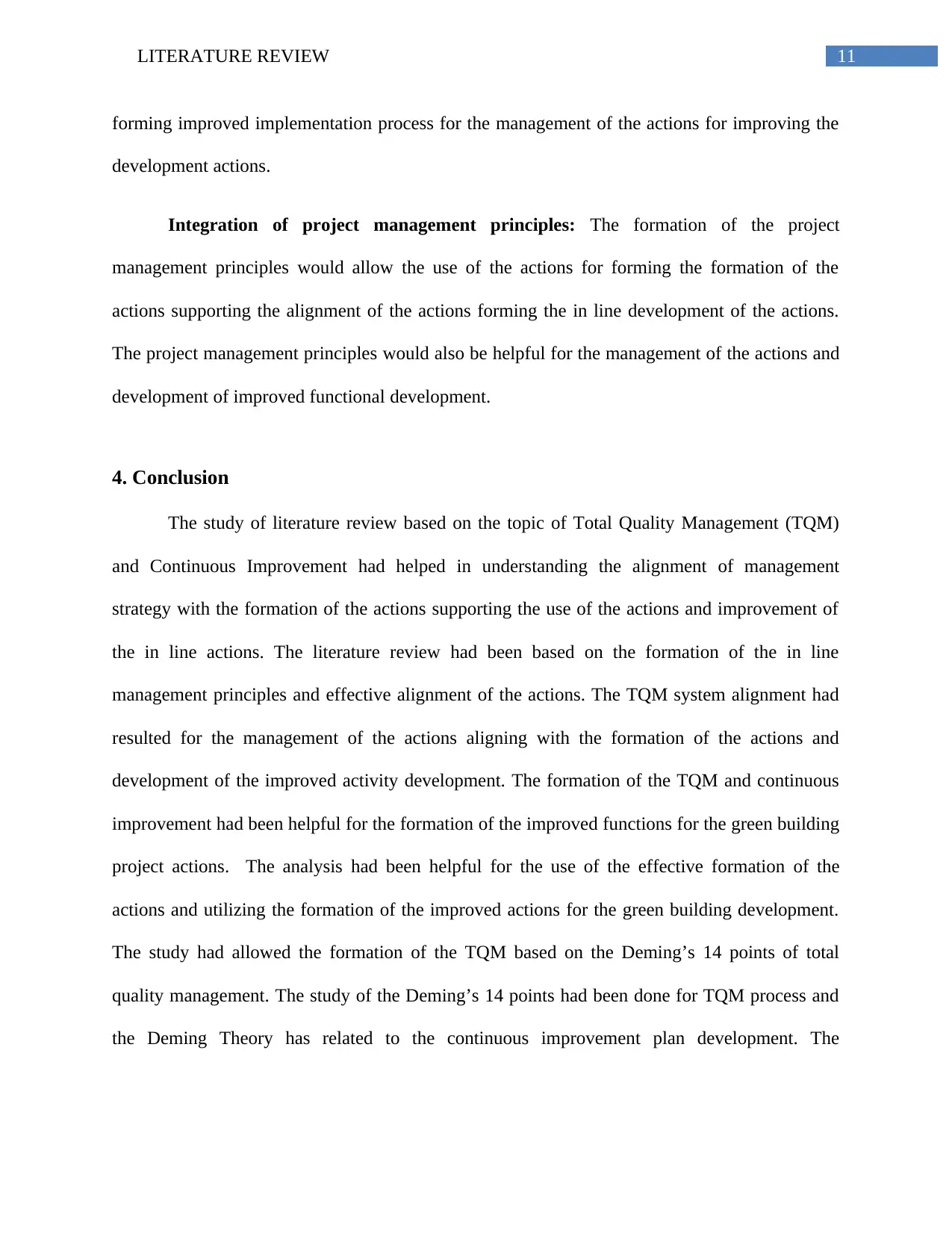
11LITERATURE REVIEW
forming improved implementation process for the management of the actions for improving the
development actions.
Integration of project management principles: The formation of the project
management principles would allow the use of the actions for forming the formation of the
actions supporting the alignment of the actions forming the in line development of the actions.
The project management principles would also be helpful for the management of the actions and
development of improved functional development.
4. Conclusion
The study of literature review based on the topic of Total Quality Management (TQM)
and Continuous Improvement had helped in understanding the alignment of management
strategy with the formation of the actions supporting the use of the actions and improvement of
the in line actions. The literature review had been based on the formation of the in line
management principles and effective alignment of the actions. The TQM system alignment had
resulted for the management of the actions aligning with the formation of the actions and
development of the improved activity development. The formation of the TQM and continuous
improvement had been helpful for the formation of the improved functions for the green building
project actions. The analysis had been helpful for the use of the effective formation of the
actions and utilizing the formation of the improved actions for the green building development.
The study had allowed the formation of the TQM based on the Deming’s 14 points of total
quality management. The study of the Deming’s 14 points had been done for TQM process and
the Deming Theory has related to the continuous improvement plan development. The
forming improved implementation process for the management of the actions for improving the
development actions.
Integration of project management principles: The formation of the project
management principles would allow the use of the actions for forming the formation of the
actions supporting the alignment of the actions forming the in line development of the actions.
The project management principles would also be helpful for the management of the actions and
development of improved functional development.
4. Conclusion
The study of literature review based on the topic of Total Quality Management (TQM)
and Continuous Improvement had helped in understanding the alignment of management
strategy with the formation of the actions supporting the use of the actions and improvement of
the in line actions. The literature review had been based on the formation of the in line
management principles and effective alignment of the actions. The TQM system alignment had
resulted for the management of the actions aligning with the formation of the actions and
development of the improved activity development. The formation of the TQM and continuous
improvement had been helpful for the formation of the improved functions for the green building
project actions. The analysis had been helpful for the use of the effective formation of the
actions and utilizing the formation of the improved actions for the green building development.
The study had allowed the formation of the TQM based on the Deming’s 14 points of total
quality management. The study of the Deming’s 14 points had been done for TQM process and
the Deming Theory has related to the continuous improvement plan development. The
⊘ This is a preview!⊘
Do you want full access?
Subscribe today to unlock all pages.

Trusted by 1+ million students worldwide
1 out of 16
Related Documents
Your All-in-One AI-Powered Toolkit for Academic Success.
+13062052269
info@desklib.com
Available 24*7 on WhatsApp / Email
![[object Object]](/_next/static/media/star-bottom.7253800d.svg)
Unlock your academic potential
Copyright © 2020–2025 A2Z Services. All Rights Reserved. Developed and managed by ZUCOL.





